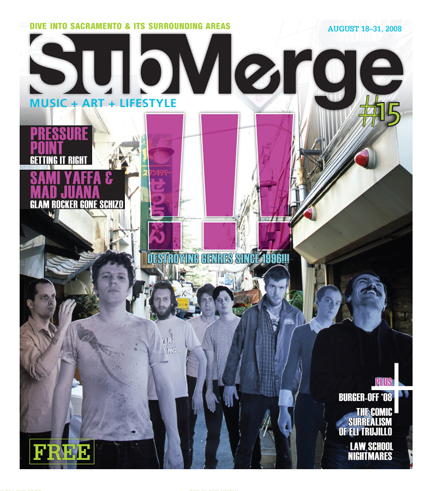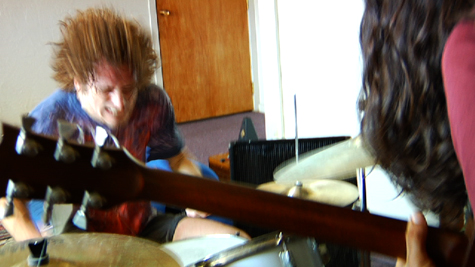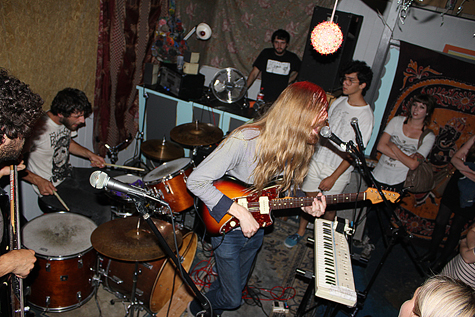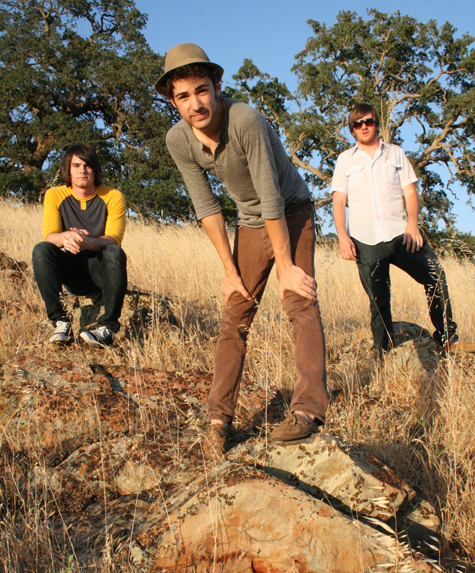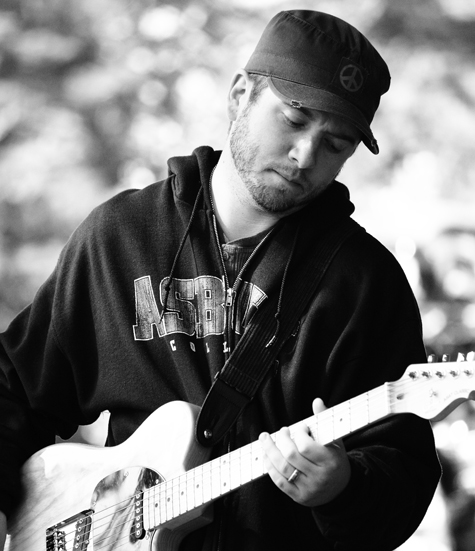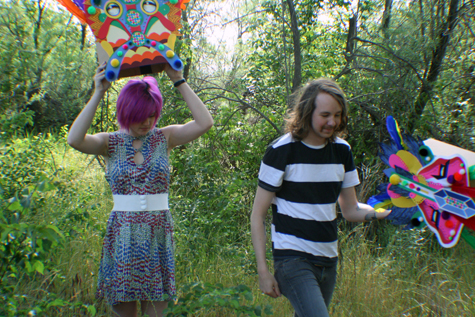Zach Hill discusses his new album and his Tao of Drumming
If Zach Hill is anything, he’s prolific. The definitive characteristic of his drum style is constant movement, an unrelenting source of rhythm. The list of musicians he has performed with extends across the globe. This year alone, his name will accompany a drum credit on five studio releases: Cryptomnesia by El Grupo Nuevo de Omar Rodriguez-Lopez, Ice Capped at Both Ends by Diamond Watch Wrists, by- from the duo Bygones, Aggressively Humble by CHLL PLL, and last but not least Face Tat by Zach Hill himself, scheduled for release Oct. 19, 2010. He plays drums for one out of six groups on Sargent House Records alone. And there are more recordings pending, the upcoming Hella record being one. Just to catch him for a conversation, Submerge had to squeeze two hours from his week-long break between a tour of South Korea and Japan with Carson McWhirter, and an Australian leg with the Boredoms he left for before we even went to press.
Hill is aware of the all this. “Not to sound pretentious, but I’ve released over 100 records,” he said. Self-taught, he’s become a financially independent musician. He states it simply, “I’m proud of most of what I’ve done.”
But to summarize his catalog is a superficial gloss of what Zach Hill is all about. Behind a quiet demeanor lies a restless mind, stirring constantly like so many endless drum fills. We talked mainly about the process of recording the new album and how his schedule creates a disruptive focus that enables him to participate in so many projects simultaneously. We also discussed the appealing qualities of an expressive live performance and improvisation. And then he left for Australia.
Face Tat is a fast-paced album full of hard-hitting drums and a million sounds that prove difficult to catalog. Multiple musicians aided Hill in his composition. “A lot of friends definitely contributed good amounts to the record,” says Hill. “Generally when I make my own records, there’s a lot of other people involved, writing, contributing musically. We record together and by the time they hear it I’ve changed it completely, in lots of different ways. Whether it was cut up or totally deconstructed or destroyed, I take whatever my friends have contributed and make it something different.”
This process, reworking the material parts and manipulating them into new sounds, is a consistent approach to Hill’s songs. In digital recording this could lead to endless editing, yet Hill has been able to stay focused. Many of the tracks have specific structures, which the guest musicians build upon, “It’s a specific idea or sound or part that I’ll ask a friend to play,” says Hill. “Or, I’ll play myself; I’ll already have a drum track, with the song entirely composed on drums, and I’ll have an idea of rhythmically and/or melodically what I want to happen. Or, I’ll be working with a series of samples of sounds that other friends contributed while they were playing with me and I’ll flip those and change them up. It’s a sound collage style, nontraditional. There’s a lot of diversity within the record. I’m excited about it.”
One exception to this process of recycling musical parts would be “Face Tat,” which is a duet of sorts between Hill and guitarist Carson McWhirter. A YouTube video is available of them recording, which reveals little change to the finalized song.
Hill’s calendar is filled with touring, which means recording the album had to be done over a long period of time. “I recorded with my friend Andy Morin at home studios all over town,” says Hill. “Because of touring and all kinds of stuff going on, other musical obligations, it was recorded over the course of a year, with breaks. I’d work on it for a month and then I’d have to leave. I didn’t want it to be genre-hopping, but I wanted to have it evolve and touch on all sorts of sources, approaches and feelings.”
The constant interruptions never felt like an obstacle for Hill, who was able to utilize his time at home. “I like working on records in concentrated periods, having focus, and then also having space away so that you can sit on it and listen to it and get an outside perspective of what you’re doing,” he says. “I work best like that, rather than just digging myself in a hole for months working on the same shit over and over and over. Sometimes having distance keeps me from changing something that is just cool how it was at first. It can keep me from working something into the ground.”
Despite the small periods of time available, Hill was able to compile a lot of material for the album, which contains 13 songs. “I always record way more than is necessary for the most part,” he says. “I’m always recording, when I’m practicing or whatever. I’m recording right now and I don’t even know what it’s for. Once I create a deadline for myself then I think about all of the things I’ve been compiling. It’s a motivator to actually finish it. Nothing’s ever really finished.”
Next spring, Hill will have the time to schedule a tour in support of Face Tat, but he says there’s much work to be done before then: “I need to put together a group to perform that material. I’ve thought about doing raw, more abstract versions of the material. It’d be awesome as a minimal three-piece, more stripped sounding. It’s not necessary to cater to the album because that’s not going to happen–based on the way it was made. For a more literal version I would need like four or five people, probably. But it would take a certain type of person or player in order to do it.”
Hill has strong motivation to play. It’s something he’s been doing for 15 years and the drums are almost a part of his consciousness. He likens working on his craft to a bodily expression: “I don’t sit there and practice rudiments all day or anything like that. To me practicing is doing a lot of different things. It’s normal for me to practice interweaving patterns and rhythms, basically not stopping for an hour. I’m improvising in free form, or with form, in and out of time. Whatever I have in my head instantly happens on the drum set without breaks. It’s just my style or whatever. I try to play infinitely, that’s my approach to practice. Zero stopping, zero pauses. Flipping things, reversing things, in and out of everything I can think of in my mind, changing speed, changing punctuation, running through everything I feel like I know on the drums. I’m connected by the drums, being able to put all of those things in any shape or form together. By practicing my brain and my body on that level, I’m able to interlock or change any kind of beat. That’s also practicing your endurance, practicing the physicality of playing the instrument.”
His description of playing drums fluidly is comparative to stream of consciousness writing, where the author lets the text move forward in composition without intent or hesitation. Hill says, “I’m really into seamlessness of playing. There’s a sound I’m always trying to achieve of hyperfluidness, and I don’t mean that in the sense of being graceful. It’s not necessarily a peaceful fashion or a proper, correct way of playing. My favorite musicians, I can’t sense them thinking about what they’re going to do next. That’s the two things I’m interested most about playing music, particularly live. A live show is all about projecting energy.”
The musical energy that Hill admires stems in a way from his mellow external mannerisms. He places it within a space of aesthetic representation: “Just like with any art form, you’re expressing something that can’t really be expressed in any other form. We all have something in us that needs some other platform to get out. Words don’t cut it; normal interaction doesn’t cut it. Talking about it defeats the purpose of even doing it in the first place. It’s a double standard because the entire reason you do it in the first place is because you can’t talk about it. I can’t even explain what I’ve got going on. That’s the whole point.”
Hill’s experiential perspective of music is evident in his experimental works and their subversive forms. “Anything I’m involved in there’s a natural tendency to be going against the grain. I’m drawn to a contrarian’s perspective. That’s just my spirit, to not accept everything at face value. That’s just what I relate to, wanting to look at things a lot deeper and I think that’s a common thread in all different forms of music,” says Hill.
In pursuing music, Hill attempts to “find something that’s relevant, or make a statement that’s of the future, not the past. I’m not a big retro person.” And ultimately Hill is quite happy to be drumming forward into tomorrow. “It’s definitely a blessing. I’m far from jaded. I’m still way grateful and really inspired to do what I do.”

The New Humans’ Avalanche Drops, Finally
Words by Vincent Girimonte | Photo by Raoul Ortega
Don’t broach the time before The New Humans with The New Humans; it’s akin to rehashing a saga and you’ve missed the first couple of installments where some real heavy shit went down. Sitting in front of Temple Coffee on 10th, that savory little nook of downtown Sacramento that feels like a downtown, Cole Cuchna and “new” singer Scott Simpson gingerly sidestep their previous selves as if they were officers in some cult; Simpson speaks briefly on his days with Sacramento rock outfit Still Life Projector while Cuchna is less forthcoming.
“I’m going to drop [Cuchna] out right now too–Cole was in a band called Red Top Road that was kind of big around the same time,” says Simpson. Once you’ve jumped from the ‘burbs, all that noise must be like Calvin Klein to Mark Wahlberg.
But nobody likes the then, especially when the now has finally shown up. The New Humans release their first EP, Avalanche, Aug. 21 with a Korg shakedown of sorts at The Townhouse, supported by Dusty Brown side project Little Foxes and those plucky FAVORS kids making their live debut. And yes, this is The New Humans’ first EP, which is no doubt a little surprising given the all the buzz The New Humans have created over the past few years, playing as an instrumental band nonetheless.
“It was never planned,” says Cuchna of the band’s instrumental phase. “We always thought the songs sounded incomplete. It was never really what we wanted to do.” Simpson took over the vocals after an arduous search for that elusive frontman, futile as they often seem to be. “We got tired of it. Trying out a bunch of people, no one was really going to grasp what we were going for besides one of us,” Simpson admits, though the group maintains that perhaps it was for the better.
The New Humans were conceived on a laptop, initially with a fairly direct “screw the guitar” mentality stemming from their previous ventures. Simpson and Cuchna, childhood friends from their days growing up in Elk Grove, wrote dozens of songs before picking up bassist Robert LaCasse and later adding current drummer, Mike Steez.
“When we started we were a lot more excited about it. I almost forget about it now,” recalls Cuchna. “Our intention was never to be like, ‘Oh check out this band, they don’t have guitars.’ I guess that would be one cool thing about us now.”
No guitars in today’s Midtown doesn’t turn any heads. It’s not uncommon to see a show with the MPC 1000 or something of the like running things on the floor, people kneeling over it awkwardly like some Ouija board. The New Humans occupy a very different side of this trend, though. Sugary, glam-y, coked-out even; it’s glitzy–not janky–in the way K Street is trying to be. “Fever” is the punchy single that predates the EP by what seems like eons, but it’s “All the Kids,” the EP’s opener, that does well to outline the album’s general framework: catchy synth melodies, live drums with percussion loops on top and a piano underneath trying to tether it all down.
“[Not having guitars] lets in the stylistic, bluesy or jazzy undertones–there’s a song on the EP with a Latin-y undertone. It lets all that color come through,” says Simpson, the pipes of this sassy “disco generation.” Some opening falsettos belie his trepidation over taking the lead vocals, and I wasn’t the first to mention that his inner diva was beginning to surface.
“I feel like every show we play, it’s coming out a little more, and in another year I’ll be a complete fucking monster.”
If there’s a sense of relief following the completion of any project, The New Humans are the divorcee who finds love again after Dad packs up and leaves. Six months were spent recording in a Sacramento studio (names are omitted per band’s request), and though both parties remain cordial, those six months were scrapped due to artistic disputes and “fake promises.”
“He wanted to produce it, so we were like, ‘OK, produce it,’ not knowing how far the producing would go,” Simpson says. “It’s a lot of trust to put in someone when you’ve never heard anything they’ve produced before. I don’t trust anybody with my band that way, unless maybe you like, produce fucking Radiohead.”
Cuchna adds, “I think that it was probably our fault for not really setting ground rules.”
Cuchna cites differences in process rather than the actual material being recorded; Simpson recollects on an uncomfortable foray into “L.A. bullshit,” where the band was allegedly being pushed into a deal with a sheisty label.
“It was a commercialized process, which could work for us, but it was an over-commercialized process,” says Simpson. “All the bands, they were trying to get them on The Hills, shit like that.”
The group self-produced with some guidance from Ira Skinner, using his studio space essentially for their own devices–“[Skinner] put in advice where we needed it and where we asked for it,” says Simpson. The New Humans purport to be in the “electric piano rock” vein, and though we can’t derive too much from that, the production doesn’t always speak to the band’s live panache–some tracks lack articulation, components grind together, coming up a little short in the “pop” factor that one generally demands with any electronic project under the umbrella of “dance-y.” But it’s their first production, more of a “demo” according to Cuchna, and he stresses the fact that they were past due on getting the EP released.
“That’s my only thing with the EP–it’s kind of all over the place…not all over the place, but we’re kind of treating it more as a demo,” he says. “At this point, we just needed to get the songs out.”
A mini-tour is planned for the fall, hopefully with a label supporting it. At this point the band is eager to get the EP “in the hands of the right people,” whomever they might be. Suffice it to say they’re in no particular hurry.
Ganglians, G.Green, Fungi Girls
Wednesday, July 28, 2010 – Undisclosed Location – Sacramento
Venues so discrete we have to refer to them as “undisclosed locations” are where the raddest shows go down. These hole-in-the-wall, permit-be-damned DIY dives are incubators for garage bands ready to put their art on parade for the ultra-knowing scene. The covert show I attended on Wednesday gave discounts to members that found out about it through a taco stand–it’s that exclusive. As a member, I was there to see a night of local celebrities in the making, a 7-inch release and three teenagers from some vast distance called Cleburne, Texas.
Fungi Girls, the band from Texas, are a strong case study as to why these shows exist. The 16-year-old lads possess one solid driver’s license, at best, between the three of them. Fungi Girls’ tour is a teen movie in the making about a summer road trip without mom and dad. If that is indeed the story, I’m eternally jealous of how those young dudes must feel traveling around the country playing gigs to strangers in California. The best I was doing at 16 was overnight basketball camps at the local college.
Fungi Girls recorded is alarmingly impressive, but a further shocker is that the lo-fi sonics translate well to the live setting. I recall a few brief moments during the more shred-heavy jams, thinking it was like watching Weezer before they were signed, which is meant as a compliment. It might be tough to stomach, but there was a time when Weezer was a celebrated comparison. It’s clear the Fungi dudes’ tastes are growing beyond Woodsist and HoZac Records catalogues, as the set flourished with songs that ripped and balanced into a few sprawling numbers–they grow up so quick.
The boys of Fungi Girls played a tight set, devoid of the minor tuning lapses. Drummer Skylar Salinas was a beast in the backdrop, stuttering in the occasional light-speed drum roll with a surgeon’s precision. (Is there a Doogie Howser joke there?) The Fungi Girls played “Owsley Knows,” a favorite that is catchy beyond belief, and closed with the A-side and B-side of its HoZac 7-inch.
Comfort is a sacrifice for good entertainment. There’s no air-conditioned room for members and as I walked in, the door girl was notified that my friend and I would be the last new entrants. This meant a packed, windowless room that sat without ventilation through the dead heat of summer, would be filled to the walls with bodies. If the lineup is hype-worthy enough, attending a renegade gig is comparable to an economy pack of tampons stuffed inside a nuked hot pocket–in this metaphor you’re a tampon.
Ganglians are back from its European tour. Besides a release party for friends G.Green, the night was a welcome home to the gangly ones. The room was a pre-heated oven, but Ganglians counteracted the burn with its breezier songs, playing a new song called “My House” and “Crying Smoke.” The latter I have never seen performed live, but it turns out I’m not the only local who feels a soaked connection to it. People in the back clapped along, heads swayed to the acoustics and the throng of front row beauties danced with each other.
Feeling at home, lead singer Ryan Grubbs announced they would play a song the band wrote the night before, proceeding to pull out his cell phone to hear a recording he made, so as to remember the chords. Shouts of “play ‘Voodoo’” were honored as Ganglians closed with the request, a song I no longer recognize.
Often I’m shameless in decrying the DIY show, as it breeds exclusivity. Last Wednesday was an exception. If it weren’t for DIY shows, Fungi Girls’ touring schedule would slim dramatically and Ganglians would not have an intimate hideout to share its demos with friends.
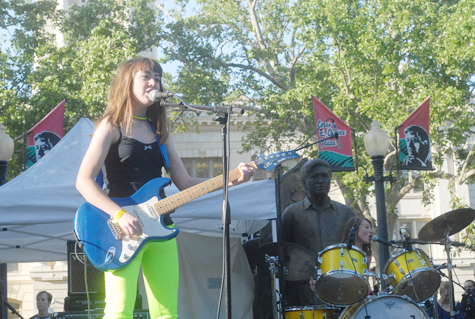
Dog Party
Concerts in the Park
Friday, May 7, 2010 – Cesar Chavez Park – Sacramento
Words & Photos by Vincent Girimonte
Two things to take away from last Friday’s edition of Concerts in the Park: one, Sacramento has some exceedingly hip youth; so hip, in fact, that I felt like a tool toting just one lens with my Nikon. Seriously though, I saw way too many kids with thousands of dollars-worth of camera gear dangling from their thin little necks. And second, make sure to buy a beer ticket before you get into the beer line–just a friendly reminder I wish someone would have given me.
Full disclosure: this was my first CIP, and for all my faux curmudgoenliness (I still get carded, for everything) it was a genuinely unique and jovial Sacramento on display in Cesar Chavez Park. Young professionals rejoiced in public consumption as kids pranced around and people were wearing balloons as hats, which would be ridiculous if it weren’t a Friday signaling the beginning of our glorious summer.

Dotting the park were food carts of all shapes and specialties, reminding Sacramentans of a culture largely prohibited to them and satiating drunks and kids alike with fatty eats such as lumpia, rice bowls, Cajun crawfish and the night’s hot seller, tamales for $1.75. About the crawfish: “They’re back” announced promoter Jerry Perry from the stage, gleefully, but at $10 a basket, I was left to lick shells off the lawn. There was plenty of affordable grub to be had, though, and $4 domestics shouldn’t elicit too much whining from anyone, though it inevitably will.
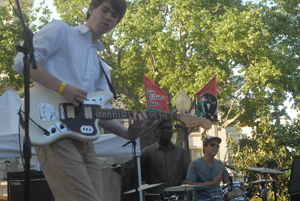
Simpl3Jack
2010’s first Concerts in the Park, now in its 18th year, was mostly about Perry and his talented lineup of youngsters, including Simpl3Jack and Dog Party of
Sacramento News & Review Jammies fame and The Kelps. The show was headlined by the sugar-spiked Kepi Ghoulie, the biggest kids of them all, who played a lengthy set of punk nostalgia piped over zany PG lyrics.
If you don’t know Dog Party, you’re likely so thoroughly out of it, you probably didn’t even know they’re just a couple of adolescent girls with a penchant for neon. Gwen “Don’t call me Meg” Giles beat drums behind her sister Lucy, who strummed her Fender, playing original tracks off their debut album and then rocking a cover of Tegan and Sara’s “Walking With a Ghost.” Two men wrestled for a T-shirt after Dog Party threw out one of their sweet XL tees–such is the zeal of their following, or perhaps the state of things these days.
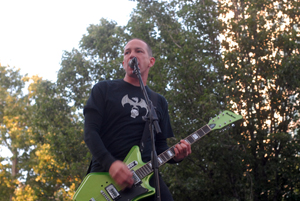
Kepi
Part Pauly Shore, part Flea in the vein of Yo Gabba Gabba, Kepi shut things down with tunes about supermodels (gross!), chupacabras (ew, yuck!) and rabid monkeys (whaaa?!). He called on the beer garden for a sing-a-long, and they reciprocated like good sports without a worry on Friday night. “Man,” he said, clearly appreciative. “We got a pretty good town.”
Hazel and Vine Go It Alone
El Dorado Hills’ indie pop sensation Hazel and Vine are making its way home. Currently out on a CD release tour, the group has spent the last seven months recording and re-evaluating its career with changes that include going DIY and becoming the procurer of its own destiny.
This month Hazel and Vine went DIY, self-releasing its self-titled album. Oddly enough, achieving this ethos of control involved the group leaving Ethos Records. Lead vocalist Kyle Monroe spoke candidly of his band’s departure from Ethos, stating it was a “no qualms” break up. “We signed on for one CD to ‘test the waters,'” he said. “It was absolutely great. Our CD was made and released in more places than we could have done ourselves, but in the process we felt like the CD wasn’t really ours. That’s why we decided to release our current album by ourselves.”
The boys took going DIY to heart, as the band’s recently released self-titled record is stripped to the core of Hazel and Vine’s musicians. Monroe said going into pre-production the group agreed that if they could not play it live, it would not be featured on the record. “I am pretty sure throughout our studio time I said the phrase, ‘It’s not real enough! Stop it!'” Monroe said. “I love the fact that we didn’t do anything we couldn’t accomplish live. What you hear on the record is what you will get live. As much as it would have been fun to make everything absolutely perfect, it wouldn’t have been that natural sound that we were going for.”
Indeed, Hazel and Vine successfully stripped its sound. The record is devoid of bells and whistles, opting to let each member contribute his respective talent to the process. Monroe said it was important that with the group’s third record, each member be present for recording. By taking this approach Monroe said it led to an understanding of each members’ significance in each song. “It’s always more positive when you have your band mates cheering you on and laughing at you when you mess up,” he said. “It allowed us to pick apart our songs and understand what each person was trying to convey with their instrument.”
The group spent 30 days in the studio with Josh Benton of Joshua Tree Studios and Dan Koch of the San Luis Obispo band Sherwood. It was a month-long regiment of arriving at the studio at 10 a.m., brewing coffee and recording until 10 p.m.
Monroe said his manager arranged for Koch to assist in recording. The band had half its songs written prior to Koch’s involvement, but Monroe insisted that had Koch not joined on, the record would not have been completed by deadline. “I am personally a huge Sherwood fan and have been since I was in high school,” Monroe said. “It was a great motivation to get off our butts and start working.”
Koch’s most significant contribution was shaping the song “The Radio Sound.” Once Koch heard the single-worthy song, Monroe said he was enamored with shaping it into a radio-friendly pop hit. The band worked with Koch in his Los Gatos, Calif. apartment, playing acoustic guitars and receiving helpful tips on roughly half the record’s songs. Monroe admits that after spending time with Koch the group applied its lessons to the remainder of the record. “The song was originally an upbeat number but very dark and very minor,” he said. “He really taught us how to focus on making a song radio-friendly without sounding like every pop band on the radio. Short songs that are to the point”¦ And I feel that is exactly what this record is… Despite our last song that is five minutes with a nice outro.”
Strict routines of locking oneself in a studio for 12 hours can lead to a slight case of cabin fever. The members of Hazel and Vine were kind enough to record video of its forays into the weirder side of studio time. Viewable on their Myspace page, one of the games played to alleviate the pressure was “sombrero time.” “We made a rule that while recording bass you had to wear this huge two and a half foot sombrero that was extremely uncomfortable and probably affected the quality of the bass tracks,” Monroe said. “But it’s OK, that’s what makes the record so special for us.”
Another entertaining video features Monroe and bassist Davis warming up in a bathroom before a show. The band jokes about the lengths it goes to find solace before a show and exercise its pipes in proper acoustics, but the bathroom singing is not limited to warm-ups. In true DIY fashion, the studio’s vocal booth was the bathroom. “Every time I would go into the vocal booth I had to go through the bathroom,” he said “It seemed that someone was always going to the bathroom while I was recording. It made it almost impossible to record when you are listening to it happen on the other side of the door.” I did not inquire further as to what “it” was that could be heard, but my hunch is it was not pleasant.
Despite a lifespan of three years and several lineup changes, Hazel and Vine have logged an impressive amount of hours touring. The band’s CD release tour takes them as far as Tucson, Ariz. and Las Vegas with a homecoming show at Club Retro on Nov. 27. Hazel and Vine will play the new record in its entirety as well as a yet to be disclosed cover. Monroe expressed an excitement for the night that will include a communal sing-a-long with friends and family. “We are going to have a lot of guest artist on stage with us; our friends in bands and people who have helped us out on this record. I’m pretty sure even my mom wanted to sing a song, but I will just have to veto that idea.”
The band plans to record the show. Those in attendance should be sure to sign the mailing list as it will ensure you two free songs to download from that night.
While Monroe seems pleased with the fruits of going DIY, Hazel and Vine are not making it the band’s staple. It’s no surprise the group enjoys reaping 100 percent of the benefits of its work. Monroe talked of this experience as an opportunity to be more business savvy with their creative passion. In his loose mentioning of the next album, Monroe said it won’t be as DIY. After the tour, the group is looking for a new studio with engineers and producers to keep the process from becoming stale.
There was no talk of finding a new label, but that could be the DIY ethic that sticks with Hazel and Vine. “We were just joking around about how we should look into managing and maybe un-officially signing other band in our area that wanted to work with us,” Monroe said. “We are always looking to help out the Sacramento music scene. Maybe not a label, but at least helping other bands get off the ground.”
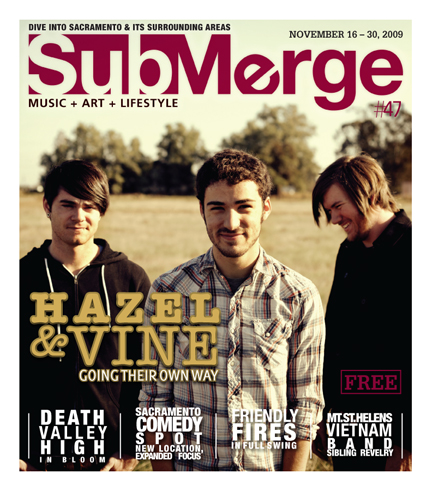
Hazel and Vine’s homecoming CD release party was at Club Retro in Orangevale on Nov. 27, 2009.
Ross Hammond and the Tao of Improvisation
At this year’s SXSW, Ross Hammond, performing with Teakayo Mission, put his rockist touch on the traditional hymn, “Let Us Go Into the House of the Lord,” leading a 14-minute tour of the heavenly kingdom. The live recording sounds as though he and his band mates reached nirvana; but for Hammond, this was just another night of performing in one of his many side projects.
It is tough to say why I feel this way, but the guitar has always been a spiritual instrument in my mind. Perhaps it is images of Jimi Hendrix kneeling in a prayer position, conjuring flames from a burning broken instrument, or the intoxicating feelings that come from Eddie Hazel’s 10-minute guitar soliloquy on Funkadelic’s “Maggot Brain.” A guitar is especially powerful when improvisation is introduced, allowing a guitarist to operate on instinct and inspiration—it is in these delicate moments that musicians seem touched by a divine muse.
Pulling the pomp from these circumstances, such musings can be reduced to just another good night for improvisational jazz—a scene that is garnering some attention in Sacramento. Ross Hammond has been operating within the limitless art form for over a decade, dividing time between improvisational groups, working as a sideman for singers and songwriters, teaching private lessons and curating local jazz shows. Some of his current projects, whether as a leader or session player, include RACE!!!, Teakayo Mission, V-Neck, Lovely Builders and Joaquin’s Night Train. Even with such a prolific resume, he’s reluctant to be dubbed torchbearer for the scene. “A lot of these projects that I’m playing in aren’t mine,” Hammond said. “There’s a lot of passing the leader title around in different projects. Usually a new project is from meeting someone new that’s into a similar idea or finding a new concept about how to present your music.”
Even in the most possessed thralls of improvisation, an artist cannot reach this higher ground without an intense dedication to the craft and community—one monk can’t run a monastery. Hammond views his eagerness to continually invite new musicians into his circle part of this ideal. “Playing with all kinds of different musicians and styles keeps you sharp,” he said. “That’s really the whole idea, in being able to play as much as I can in as many styles as I can.”
Hammond’s predilection for an unabashed marriage of style and technique are the principles for his latest solo record, An Effective Use of Space, a title penned by his wife. “It’s a phrase [she] likes to use when we talk about how things should be arranged in our house,” he said. “I’m sure someone could make a good musical meaning for it too. But it was more of a title that was given after the fact.”
Essentially, his wife has unwittingly helped this writer do just that, as his album suggests jazz feng shui. In a traditional sense, feng shui is an ancient Chinese system of aesthetics for improving ones life through placements of positive energy, but Hammond’s feng shui comes from his guitar-plucking intuition. The record also features several stylistic choices that require delicate placement.
[audio:Heaven Was Getting Crowded.mp3]
Hammond occasionally deviates from his signature sound to pose dedications to friends and family. One of his favorite songs is “Heaven Was Getting Crowded,” which features his recently departed grandmother—Hammond recorded her delivering this joke during her final stay in the hospital. “I wanted to get a recording of her telling her favorite joke, so that’s pretty much how it came out,” he said. “She was a very loving and supportive lady, and she loved to make people laugh. She would tell us and the doctors and medical staff jokes up to her final days.” Without overshadowing the recording, he supports his grandmother’s joke with a bittersweet mood created from solo electric and lap steel guitar loops. “The song is meant as a way to remember her jovial side,” he said.
Once again, I recall Hammond’s SXSW recording. It is as though his guitar is in deep meditation, yet there’s an unspoken connection with his band mates. The spiritual is the constant, while the exploration of a deeper understanding is ritually being sought throughout the performance. “I try to communicate whatever I’m feeling in the moment,” Hammond said. “That obviously has some day to day changes, but there are some parts of my personality that are pretty much constant.” Originally from Lexington, Ky. and raised in the church, Hammond’s spirituality is connected to his guitar playing. “I think most improvisers are that way,” he said. “You should be able to get an idea of what a person is feeling by listening to them play. I think that’s what keeps improvised music honest. But there’s also the factor of what your other band mates are doing. So, it is definitely a balance of trying to get across what you feel while still listening to what’s going on around you.”
The practice of meditation in Eastern religions holds relevance to the improvised jazz performer. Obtaining Zen through meditation involves intense mental stamina as a person directs awareness toward breathing or counting until he or she establishes a trance state. Improvised music shares principles with meditation, as the beat is the groundwork for the journey that comes from reacting to your group and the impulses you feel in the moment. “It’s like you are an antenna that is channeling the music from somewhere else,” he said. “When I play, I’m definitely not thinking about scales or keys. There’s an old adage that says if you are thinking when you play, then you’re gonna muck it up.” Once again, Hammond likened it to his personal experience of participating communally in church, “I think that is a very spiritual thing, because in that sense the music is something that is bigger than just me and whoever I’m playing with. It’s definitely greater than the sum of its parts. I think it’s a similar feeling as being in church, or meditating or whatever else people do to escape. When you are improvising it’s a timeless feeling in that it’s hard to tell if the song you just played was five minutes or 45 minutes.”
Hammond stresses that, though time loses its relevance while performing and the transcendental progression is intoxicating, it is important to hold dear to your purpose. For Hammond, creating is far beyond notes on staff paper, matching scales to chords and counting beats. He spoke with restraint, worried he’d sound too “new age-y,” relating that he created “to convey a sense of unity and harmony in the world we live in.”
Finally, I asked Hammond if he thought his style of improv-jazz was less intimidating than most jazz because of its focus on the guitar and crafting soliloquies. He resisted my hypothesis stating, “I don’t see jazz artists like John Coltrane or Pharoah Sanders being that much different than Pete Seeger or Bob Dylan,” he said. “They are all trying to convey a message through their music. That’s the important part. I think at this point jazz just means ‘not pop.’ Just play what you are feeling. That’s where the real music lies.”
Relentless About the Music
Forget about your one-hit wonders and starry-eyed kids just breaking into the music scene. Despite a lack of local publicity, Another Damn Disappointment has been a staple of the Sacramento music scene for a good 10 years and has a lot to show for it.
“We’ve done rad shit,” says singer and songwriter Josh Thompson. “Our shit was on MTV’s The Real World, in the background. I’ve been driving through other states and heard our stuff on the radio. But in Sacramento, we’ve had zero recognition.”
This lack of love from their hometown is partially responsible for their name, Another Damn Disappointment, a name which was chosen midway through the band’s career. In the early years, the band was known simply as ADD, an apt name considering two of the members of the band actually had Attention Deficit Disorder, and that their musical style was “punk-rock fast,” as bass player Casey Marsullo says.
The name Another Damn Disappointment was added later, when a record label prodded them for a more distinctive name. Considering the band’s dissatisfaction with the Sacramento music scene, this name is equally appropriate. “We have a great fan base here and a big following, but no one really sticks [up] for us. We’re on the radio all the time and KWOD has always been really nice to us, but as far as anything else goes, this city I don’t think supports its bands,” Thompson explains.
But ADD didn’t let this get them down. They started playing in Los Angeles, and found the crowd to be much more receptive to punk rock music. They’ve played all across the United States and Canada, including two summers of playing on Vans Warped Tour, a CD release show with Pennywise on Catalina Island and a show at House of Blues, Anaheim. “We’ve toured our asses off: Vancouver, Seattle, Portland, New York, Kansas, Florida, pretty much every major city you can think of,” says Marsullo.
In Sacramento, their hearts still go out to The Boardwalk, which is where they played their first show. “The first year we played there almost once a month and just packed it in,” Marsullo says. “That’s how we built up a reputation with promoters. [They were] like, God, ADD packs it in there! Where did this band come from?”
In the beginning, ADD was just a bunch of punk kids who wanted to be part of the music scene. “After years of going to punk rock shows and getting beat up in the mosh pit, one day I was thinking that it would be kind of cool to be the guy onstage looking down on that instead of the guy in it,” Marsullo remembers. They got together with some buddies at Folsom High, including current guitarist Ross Standley, and started playing, and it was crap. Thompson says, “We were so into punk and living that lifestyle for so long that it didn’t even matter that we sucked. We had the desire to play punk music so much that it was overwhelming everything else.”
Marsullo adds, “We just kept rocking.”
Luckily, the talent came with time. And just as the music grew and changed, so did the band members. In 2007, they added a second guitarist, Aaron Welch, who had been a fan of the band for quite a while. Thompson remembers that when Welch came to try out for the part of rhythm guitarist, he blew them away with his talent, he knew all of the songs, even the solos. It turned out that Welch had a degree in music, knew how to record and even listened to all of the same music. “It was a perfect fit,” Thomspon says.
ADD has been through their share of drummers before current drummer Carl Chang joined a couple of months ago, and every drummer has been better than the last. “It’s like the missing piece that needed to be there,” Thompson says about Chang. “[He is] the epitome of a bad-ass drummer.”
Thompson writes all the lyrics, usually while drinking a lot of coffee and taking some Adderall, he says. “Usually I will try to do a couple about society or politics, whatever bullshit is going on,” says Thompson. “And then there’s always the woman in my life that’s fucking me up. I’ll probably write a few about that. Standard punk rock.” And of course, a few songs are dedicated to going out and getting drunk.
Their first album, Quarter Life Crisis, was self-produced and came out in 2000. They describe this album as being “pop-y punk.” Next, they released Hooligan through Volcom Entertainment, which was a little more aggressive and dark than their first. Their new album will be released through Felony Records, and they describe it as being more “metal-punk.” It is called Relentless, which pretty much describes the attitude of the band. Thompson says, “Through all the trials and tribulations, whatever bullshit that has gone down, [we are] relentlessly playing.” The cover art illustrates this idea. Thompson describes it as, “an old fifties style bomber plane being shot and going down in smoke but still firing its guns, not stopping until it’s dead.”
Their sound has changed a lot since the band’s formation, continuing to move away from traditional punk music into a darker and more mature sound. Thompson explains, “The band’s talent level kept on getting better, so the music is just adapting. We can do so many more things now, especially with Aaron being on board with the second guitar.”
Although Relentless hasn’t even been officially released, they are already hard at work on their next album, and have four songs written. Thompson and Marsullo agree that this next album will be, overall, just the next step in their musical talents, heavier and more intricate. “[There are] more interesting things going on rather than your standard four-chord punk rock song,” Thompson says.
Goals for the near future? “I’d like to see this record really take off,” Thompson says. “It’s the first CD that we’ve done that I’m actually really proud of and I’m fully backing.”
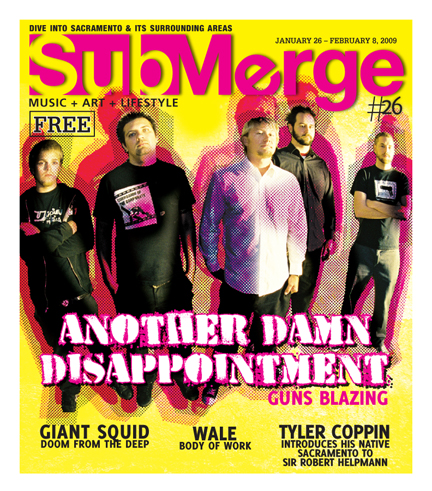
20,000 Breaks into the Sacramento Music Scene
Comprised of locals David Mohr and girlfriend Meg Larkin, the band 20,000 is relatively new to the Sacramento music scene—but with their youthful energy and down to earth attitudes, it’s no wonder that fans are quickly tuning in. “By default, I usually just say it’s dance music with guy/girl vocals and synthesizers,” Larkin says about their style. Even if you’re not typically a fan of dance music, there is no doubt that the upbeat tempo and catchy lyrics of 20,000 will have you up and out of your seat in no time.
It started as a dream—literally. Mohr says, “I had a dream a while ago that we had a band and we named it 20,000.” Both Mohr and Larkin are adamant that if you dream it, you must do it, and thus 20,000 was born. “If you do what you do in your dreams in real life, then it’s almost like you’re predicting the future,” Mohr says.
“Yeah, it’s true,” Larkin adds. “If you dream that you’re wearing red socks, you have to buy a pair of red socks and wear them.”
About two years ago, sparks started flying, musically, that is. Mohr began writing music on his computer, and then he and Larkin started adding vocals. Mohr says, “When I was writing the songs for the album, I was listening to music that has a lot of synths in it, but not necessarily electronic music.” They cite musicians such as Prince, Talking Heads and Hot Chip as being very influential during that time period. Larkin says, “Up until a couple of years ago I never really listened to dance music, but it’s some of my favorite music now.”
The goal for their music is simple: create songs with a good beat that people will want to party and dance to. Mohr says, “While we were recording the album, I was thinking it would be cool to just have a good CD for people to listen to in their houses at parties.” He writes all of their songs, and is no stranger to the music world. He played with some of his high school buddies in a band called Didley Squat for about six years, and when that gig dissolved, he naturally transitioned into forming 20,000.
While they had been diligently practicing and recording songs at home for many months, their first live performance happened this past August, at Old Ironsides. “We were apparently really visibly nervous,” Larkin remembers. “I was wearing short shorts and this crop top, just trying to be funny, but it was the most intimidating outfit to wear in front of people as a joke.” While their first show was definitely nerve-wracking, a lot of their friends came out to show support and it was a fun experience that paved the way for future shows. Other than Old Ironsides, they’ve played at Javalounge, Luigi’s Fun Garden and Blue Lamp.
When transitioning to live performances, Mohr says that one of the biggest challenges is figuring out how to make everything sound right in such a drastically different environment. After spending two years perfecting their songs in their apartment with only a tiny set of computer speakers—and trying to keep the noise level down so as not to disturb the neighbors—they now had to create a seamless performance in a real venue.
For Larkin, there was the added challenge of being brand-new to the music scene. She had been involved with musicals during high school but had no prior experience with playing an instrument. “When we decided to start playing live shows, I learned how to play rudimentary keyboard,” she says. This was completely terrifying at first, and she remembers being nervous for six or seven hours before a show, to the point where she could barely eat or drink. But as time went on and performing became more commonplace, her nervous energy eventually went away, and now she loves the thrill of shows. “When we have a show and there’s people responding to it and everyone is nice it’s like, yes! We’re the best band ever! Let’s do this every night!”
Both members play keyboards and sing, and their drumbeats are on an iPod. This means that they can carry all of their instruments to a show and set everything up on their own—no roadies required. “It’s super easy for us to set up,” Larkin explains, adding that it literally takes about four minutes. “Just put the keyboards on the stand, plug it in, turn the iPod on and we’re set.”
Although perhaps they hadn’t planned to “make it big” in the music business, the Sacramento music scene has been good to 20,000. Larkin is surprised at how easy it has been to get shows that they really enjoy. Their friends have also been extremely encouraging in this new venture. Larkin says, “It’s definitely been cool to see how supportive our friends have been, getting them to come out and pay for shows over and over and over again.”
20,000 will likely become a common name in the Sacramento area as time progresses. The couple is ecstatic about their 2009 New Year’s Eve show at Blue Lamp, which has been the biggest show they’ve played so far.
You can check them out on Myspace: www.myspace.com/20000music.
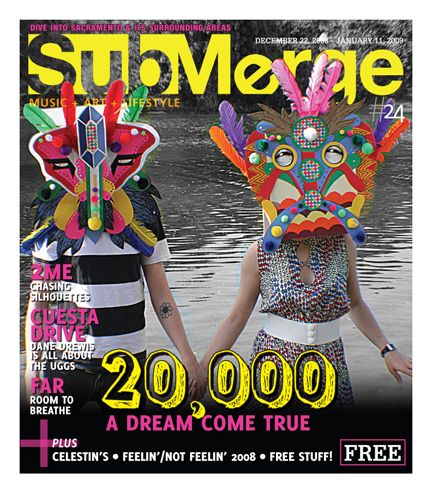
!!! Wants You to Slam
When the collective runoff of ballyhooed Sacramento bands Black Licorice and Popesmashers joined forces after a mid-’90s tour, they probably didn’t realize their labor would yield the seeds for the forbidden fruit of dance-punk. They probably didn’t even realize that what they were doing was all that unique. But however you slice it, the niche-malleable !!! (yes, you can pronounce it in any number of thrice repeated bursts of syllables—most commonly Chk Chk Chk, but don’t forget Pow Pow Pow, Bam Bam Bam or any other such triadic inference) introduced to the fringe-stream a hypnotic freak beat mythos that spawned more bastard-children experimentalists than had Wilt Chamberlain studied Blondie rather than basketball. Their symbiotic mastery of marrying organic jams into heady blips of post-punk funk has afforded them opening slots on major tours (2006’s opening slot in support of Red Hot Chili Peppers in the UK), and has paved the way for the moderate successes of their last two studio albums: 2004’s Louden Up Now and 2007’s acid-punk/funk field guide Myth Takes. The band is currently on a brief West Coast tour, slowly wrangling their brigade from various corners of the country to once again coalesce and steer the vessel even deeper into uncharted waters, or as guitarist Mario Andreoni alluded to Submerge, to blindly forge straight into the dock. Either way, bring a life vest and some deck-safe dancing shoes.
!!! has its foot planted nowhere specific musically. How liberating as an artist is it for you to not feel pressure to homogenize your craft to fit into a niche?
Well, we do tend to work on things that have a strong rhythmic foundation so”¦ From there, it’s pretty wide open though. I don’t worry too much about the rest.
The indefinable aspects of your music often surface as the focal point of it as well; abstracts become hooks, dissonance becomes harmony. Are you ever concerned that by way of the indefinability of your music that your songwriting is guided toward that indefinability rather than emerging from an organic jam?
If part of me was concerned about that, I’d want the other collective parts of me to punch that part in the face.
Being one of the forbearers of the progressive dance/funk scene, what trends do you see infiltrating the mix that you guys are really into? Which trends are you seeing that you think are detrimental?
Being a fan of lots of old obscure/odd/forgotten dance tunes, I tend to really like freaky re-edits—creative DJs or producers reinterpreting songs, making them longer, adding bits. What I dislike, though, still comes down quality. I want a good tune. Subjective, I know, but I don’t keep up on what [the] latest things [are] in any musical genre—sort of blissfully unaware.
Is the band still spread out across the country? And if so, how is your chemistry affected when you reconvene for small tours like the one you’re on now, or when you get back together to create music?
Yeah, most of the guys live in Brooklyn while Allan [Wilson, horns, percussion] and I live on the West Coast. We toured most of last year and that probably had more of an affect on our chemistry than the separation ever did. I’m frankly used to [the separation], although it’s certainly not the easiest way to make music as a band.
In what ways do you feel making an artistic statement with your music is important? How does that stack up against playing music just because you enjoy it? And where do those two roads cross paths for !!!?
When creating, I don’t make the distinction. If we’re working on a tune and it makes me smile, gives me goose bumps or some other crazy feeling, I go with it.
What are the band’s plans for a new album?
Working on new tunes now. Ideally, I’d like to have most of it recorded by end of this year, but we’ll see. It’s still early in the process. The goal is to keep making better records, which I think we’ve done. I’m sure it’ll slam though.
In what ways has the Sacramento music scene changed since you guys began playing?
!!! came out of a pretty tight downtown community. Once that “ended,” I’m not sure who picked up the torch. I sure hope there is some weird small scene brewing in Loomis, or Rancho, or Folsom”¦doing more than just anger-rock that is, which seems to be a pre-requisite to getting any “pro” rehearsal slot—in just about any city. People outside of Sacto always wonder about what was going on around the time we formed; it was really great to be around so many smart, supportive and open-minded music snobs.
